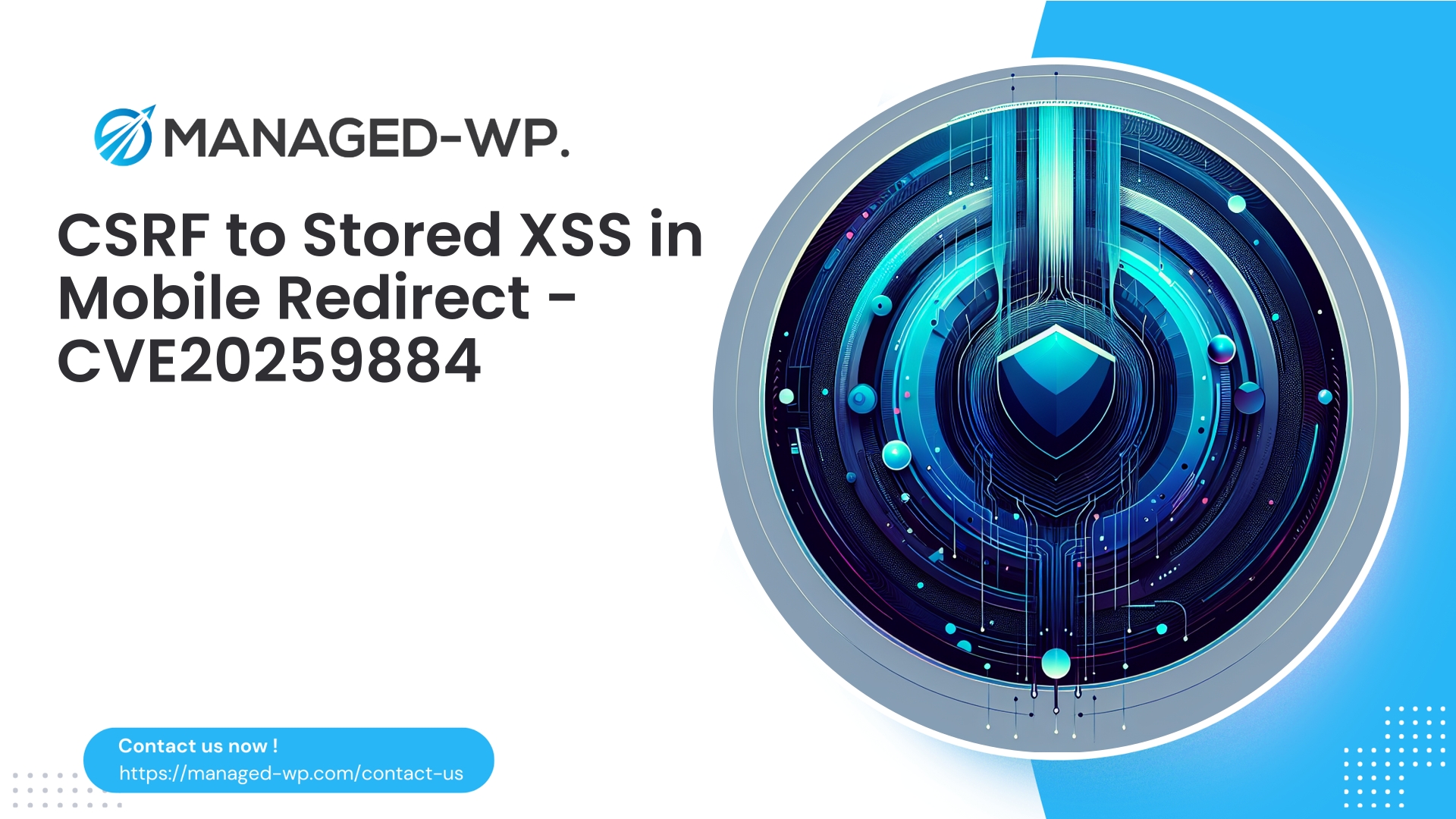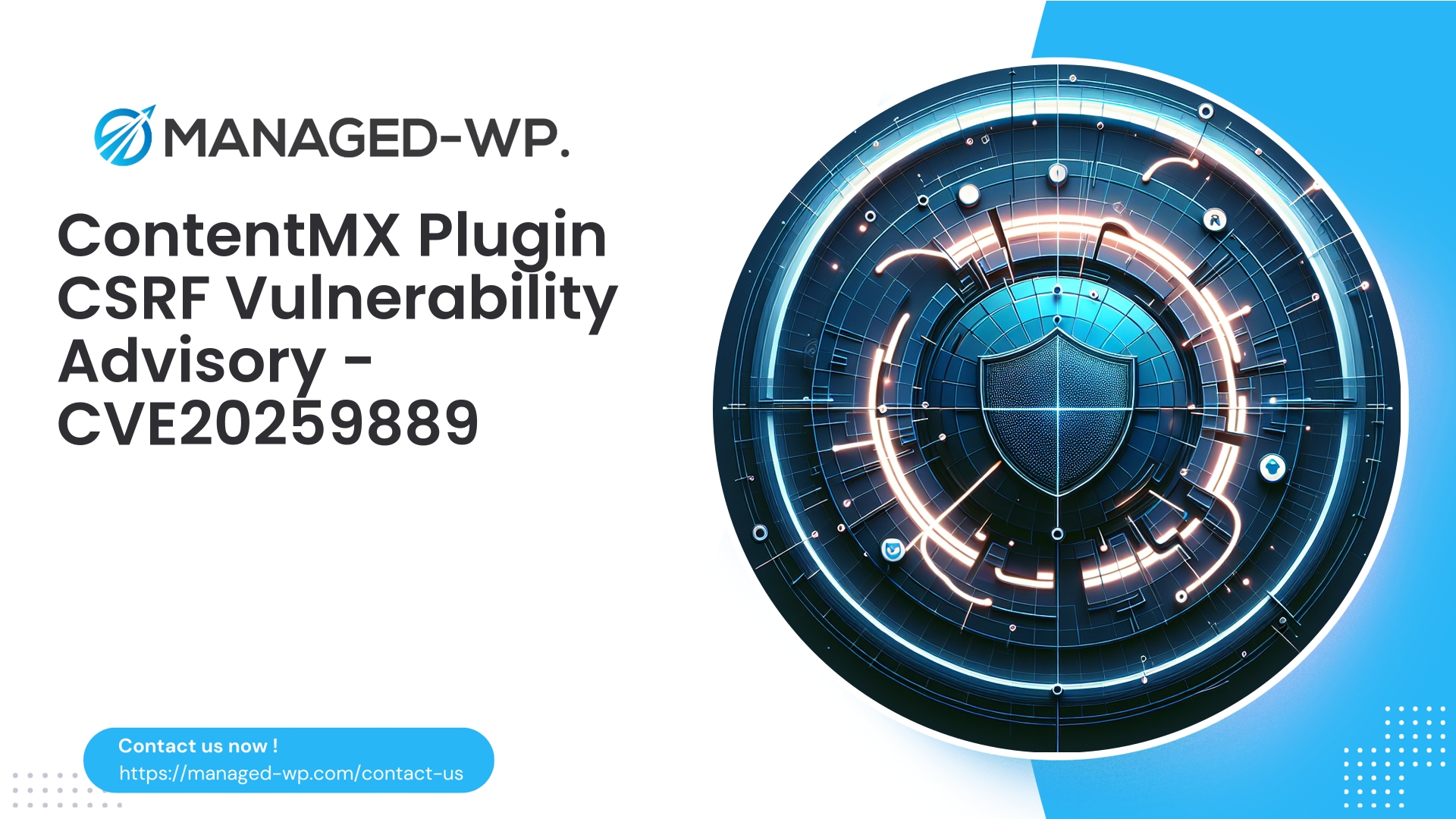| 插件名称 | 移动网站重定向 |
|---|---|
| 漏洞类型 | 存储型XSS |
| CVE编号 | CVE-2025-9884 |
| 紧急 | 低的 |
| CVE 发布日期 | 2025-10-03 |
| 源网址 | CVE-2025-9884 |
移动网站重定向(≤ 1.2.1)— CSRF 到存储型 XSS 漏洞 (CVE-2025-9884):WordPress 网站需要立即采取的措施
近日,WordPress 插件“Mobile Site Redirect”被披露存在一个严重漏洞,影响所有 1.2.1 及更早版本(CVE-2025-9884)。该漏洞的核心在于其跨站请求伪造 (CSRF) 防护不足,使得恶意攻击者能够注入持久性或存储型跨站脚本 (XSS) 攻击载荷。存储型 XSS 漏洞构成重大威胁:攻击者可以在管理员或访客的浏览器中执行恶意 JavaScript 代码,从而导致包括会话劫持、未经授权的管理操作以及注入后门或恶意软件在内的各种攻击。
作为 Managed-WP 致力于为 WordPress 网站所有者和管理员提供专家安全指导的一部分,本文全面而实用地分析了所涉及的风险、验证漏洞存在的方法、立即遏制策略、清理方法以及加强网站防御态势的长期安全措施。
重要的: 本文档有意省略了漏洞利用代码或详细的攻击方法。我们的目的是让您掌握必要的知识,以便进行防护、检测和修复,而不是助长恶意活动。
简要总结:接下来该做什么
- 验证是否 移动网站重定向 如果已安装且版本为 1.2.1 或更低;如果是这样,请将您的网站视为存在漏洞。
- 如果无法立即更新插件,请禁用或删除该插件以消除风险。
- 如果您使用 Managed-WP 的安全服务或同等保护层,请实施虚拟补丁或托管 Web 应用程序防火墙 (WAF) 规则。
- 对文章、页面、小部件、插件设置和数据库条目进行彻底扫描,查找存储的 XSS 有效载荷。
- 更改所有管理员密码,终止活动会话,并对管理员强制执行双因素身份验证 (2FA)。
- 请按照以下概述的补救和加固清单进行操作,以控制并彻底恢复任何安全漏洞。
了解漏洞:CSRF 和存储型 XSS 详解
此漏洞涉及两个相互关联的安全问题:
- 跨站请求伪造(CSRF): 攻击者诱骗合法的网站用户(通常是管理员)在不知情的情况下执行不希望执行的操作,因为该插件缺乏强大的反 CSRF 保护措施,例如 nonce 或能力检查。
- 存储型跨站脚本攻击(存储型 XSS): 恶意 JavaScript 代码会永久嵌入到您网站的数据库中。每当渲染受影响的内容时,注入的脚本就会在访客或管理员的浏览器中执行。
移动网站重定向插件的缺陷允许攻击者利用 CSRF 问题注入存储的 XSS 有效载荷,从而有效地植入持久性恶意脚本,这些脚本会在访问相关页面或管理屏幕时激活。
存储型跨站脚本攻击(XSS)会造成严重后果。潜在的攻击影响包括:
- 窃取 cookie、会话令牌和反 CSRF nonce。
- 未经授权的管理更改,包括创建新的管理员帐户。
- 植入更多后门或持久性恶意软件。
- 恶意流量重定向、搜索引擎优化投毒或网络钓鱼。
- 在访客浏览器上部署加密劫持脚本或凭证窃取程序。
漏洞利用通常需要用户交互(例如管理员访问精心构造的 URL)或利用接受未经身份验证的请求的保护不足的端点。
哪些人面临风险?
- 任何运行 Mobile Site Redirect 版本 1.2.1 或更早版本的网站。
- 即使没有活跃的管理员登录账号,网站仍然会因为访客暴露而面临风险。
- 使用特权浏览器登录的管理员特别容易受到连锁攻击,导致网站完全被接管。
- 没有自动插件更新或持续运行监控的网站面临更高的检测延迟和风险。
如何确认您的网站是否存在漏洞
- 插件验证:
- 登录 WordPress 控制面板 → 插件 → 已安装插件。
- 如果存在移动站点重定向且版本≤1.2.1,则认为该站点存在漏洞。
- 文件系统检查:
- 通过 WP-CLI 或 FTP/SFTP 检查
/wp-content/plugins/mobile-site-redirect/目录。 - 查看插件文件或 readme.txt 文件头以获取版本信息。避免执行任何插件代码。
- 通过 WP-CLI 或 FTP/SFTP 检查
- 数据库检查:
- 搜索 wp_posts、wp_options、widget 表以及任何插件特定的表,查找可疑的内联代码。
<script>标签或编码后的 JavaScript 有效载荷。 - 在进行任何更改之前,务必执行只读查询或将数据库导出到安全的暂存环境。
- 搜索 wp_posts、wp_options、widget 表以及任何插件特定的表,查找可疑的内联代码。
- 日志和流量分析:
- 检查服务器访问日志,查看是否存在针对插件管理端点的异常 POST 请求,尤其是来自未知 IP 地址的请求。
- 检查是否存在可疑的外部引用来源,这些来源通常位于异常插件相关请求之前。
如果检测到与插件相关的可疑注入脚本或重定向行为,请将该网站视为已被入侵,并立即采取遏制和清理措施。
立即采取的缓解措施
发现移动网站重定向存在漏洞且正在使用后:
- 您可以选择将网站设置为维护模式,以最大程度地降低访客风险。
- 通过 WordPress 控制面板停用插件(插件 → 停用移动网站重定向).
- 如果您没有控制面板访问权限,请通过 SFTP/SSH 重命名插件文件夹(例如,
移动网站重定向已禁用). - 如果您使用 Managed-WP 的安全平台或任何 WAF,请启用专门设计的规则来阻止针对此漏洞的已知利用模式。
- 重置所有管理员密码并撤销所有活动会话:
- 通过“用户”→“所有用户”,注销活动会话或清除用户元数据中的会话令牌。
- 考虑对所有具有较高权限的用户强制执行密码重置。
- 立即为所有管理员帐户启用双因素身份验证 (2FA)。
- 为了便于取证和恢复,请对您的网站文件和数据库进行全面备份。
- 对您的网站进行强化监控,包括记录管理员端点访问日志和实施文件完整性检查。
笔记: 如果您的网站面临无法中断的高流量生产环境,启用 WAF 防护是首选的短期措施,因为它既能阻止攻击,又能保持网站功能正常。否则,停用插件仍然是目前最安全的应对措施。
Managed-WP 如何在等待补丁期间保护您的网站
Managed-WP 提供多层防御机制,即使插件补丁尚未发布,也能保护您的 WordPress 网站:
- 托管 WAF 规则: 有针对性且不断更新的规则可以检测并阻止已知的漏洞利用尝试,而无需更改插件代码。
- 虚拟修补: HTTP 层请求过滤可以防止利用 CSRF 验证缺失或不安全输入的攻击流量。
- 恶意软件扫描: 高级扫描功能可检测注入的脚本、可疑的文件更改以及表明系统已被入侵的数据库有效载荷。
- 事件缓解: 自动拦截、验证码挑战、黑名单和速率限制降低了攻击者的有效性。
- 免费计划保护: Managed-WP 的基本免费套餐提供必要的防火墙、WAF 和恶意软件扫描功能,可以立即降低风险。
对于即时加固和防御,Managed-WP 的安全平台是对您的补丁和修复工作的有力补充。
全面控制和清理清单
- 隔离和备份:
- 创建所有文件和数据库快照的备份,理想情况下应备份到服务器快照级别。
- 如果可能,将受影响的站点克隆到暂存或测试环境中进行安全分析。
- 停用或移除存在漏洞的插件:
- 在完成安全更新并确认清理工作之前,请保持插件禁用状态。
- 扫描存储的 XSS 有效载荷:
- 查询数据库,查找可疑的内联脚本,例如:
SELECT * FROM wp_options WHERE option_value LIKE '%
SELECT * FROM wp_posts WHERE post_content LIKE '% - 还要检查组件表和任何插件特定的表中是否存在编码的脚本标签。
- 警告: 切勿在生产环境中执行破坏性数据库更改而没有备份。
- 查询数据库,查找可疑的内联脚本,例如:
- 移除恶意注入内容:
- 清理或删除包含可疑脚本注入的数据库记录。
- 如果感染范围很广,请从已知干净的、在感染发生之前的备份中进行恢复。
- 在恢复用户访问权限之前,请确保已移除或修补存在漏洞的插件。
- 文件系统清理:
- 利用文件完整性监控工具识别已更改的文件。
- 用经过验证的干净副本替换 WordPress 核心文件和插件文件。
- 扫描上传文件和可写目录,查找未经授权的 PHP 文件或 webshell。
- 轮换凭证并撤销会话:
- 更新管理员和其他特权用户的密码。
- 撤销网站上存储的 API 密钥、OAuth 令牌和任何第三方服务凭证。
- 强制所有用户注销,方法是清除会话令牌。
- 检查是否存在后门:
- 检查定时任务、计划任务和管理员用户是否存在可疑的新增内容。
- 检查服务器配置文件(.htaccess、nginx conf)是否存在未经授权的重定向或规则。
- 清理后硬化:
- 为所有管理员启用双因素身份验证。
- 通过移除不必要的管理员用户或降低权限,应用最小权限原则。
- 通过 wp-config.php 禁用文件编辑
定义('DISALLOW_FILE_EDIT',true); - 维护托管式Web应用防火墙(WAF)并定期进行恶意软件扫描。
- 持续监测:
- 密切监控日志,检查是否存在重新注入尝试和异常访问模式。
- 密切关注登录失败尝试和可疑的流量高峰。
对于复杂或严重的安全漏洞,请考虑聘请专业的事件响应团队或您的主机安全团队。
如何发现剥削迹象
- 文章、小工具或插件选项中出现意外的脚本标签或内联 JavaScript。
- 未经授权创建新的管理员用户。
- 对重定向、域名或自定义 HTML 设置进行了您未曾进行过的调整。
- 垃圾前端内容、SEO垃圾内容或大规模重定向循环。
- 通过注入的 JavaScript 向可疑的外部域发出出站调用。
- 服务器日志中出现针对插件端点的异常 POST 请求,尤其是缺少引用来源或奇怪的用户代理。
- 访客浏览器 CPU 使用率过高或存在加密货币挖矿活动。
如果出现这些迹象中的任何一个,则说明您的网站已被存储型 XSS 攻击,请按照上面的清理清单进行操作。
为什么从 CSRF 到存储型 XSS 的攻击链尤其危险
虽然 CSRF 单独就能让攻击者诱骗用户执行非预期操作,而存储型 XSS 则能实现持久的 JavaScript 执行,但二者结合使用威力更大。攻击者利用 CSRF 防护薄弱的漏洞,将恶意脚本偷偷植入网站数据库,然后以管理员或已登录用户的完整权限执行这些脚本。这使得攻击者无需直接窃取凭据,即可悄无声息地接管网站。
在管理员上下文中执行的存储型 XSS 漏洞允许攻击者以编程方式操纵 WordPress 管理界面——创建用户、更改设置并部署持久性后门。这种连锁反应使风险远远超出单个漏洞所能造成的程度。
优先处理您的回复
- 插件是否已安装并启用?
- 如果是,则需要立即采取缓解措施(停用或应用 WAF 虚拟补丁)。
- 如果没有,风险较低,但仍需检查是否存在先前的妥协情况。
- 是否存在存储型 XSS 攻击的迹象?
- 如果属实,则按安全事件处理,并进行全面控制和补救。
- 如果没有,请保持警惕,并考虑虚拟修补和加强监控。
- 您的网站是面向公众且访问量很大的网站吗?
- 访客数量过多会增加紧迫性,因为存在客户曝光和声誉受损的风险。
主动强化和预防策略
- 保持 WordPress 核心、主题和插件为最新版本。
- 仅从可信来源安装插件,并定期审核已安装的插件。
- 强制使用强密码,并要求使用双因素身份验证(2FA)。
- 遵循最小权限原则:尽量减少管理员账户。
- 实施内容安全策略 (CSP) 标头以阻止未经授权的内联脚本。
- 在适当的地方设置带有 HttpOnly 和 SameSite 属性的 cookie。
- 通过以下方式在控制面板中禁用文件编辑:
禁止文件编辑指示。 - 使用托管式WAF解决方案和具有虚拟修补功能的自动化恶意软件扫描。
- 启用对 HTTP 请求、身份验证尝试和文件更改的日志记录和监控。
开发者最佳实践
如果您开发 WordPress 插件或主题,请通过以下方式避免此类漏洞:
- 通过以下方式强制执行严格的能力检查
当前用户可以()所有管理员操作。 - 利用 WordPress nonce 并对其进行验证
wp_verify_nonce()降低 CSRF 风险。 - 使用适当的功能对用户输入进行清理,例如
sanitize_text_field(),esc_url_raw(), 或者wp_kses_post(). - 对所有输出进行上下文转义(例如,
esc_attr(),esc_html(),esc_js()). - 避免在未转义的情况下将未经清理的 HTML 存储在选项或数据库字段中。
- 尽量减少管理员初始化的、接受 POST 请求而不验证用户意图的端点。
- 定期进行安全审计和代码审查,重点关注远程配置功能和数据清理。
与利益相关者和用户沟通
- 通过解释漏洞、受影响的版本以及采取的缓解措施(停用插件、启用 WAF、主动扫描)来保持透明度。
- 如果涉及敏感数据或付款,请遵循适用的数据泄露通知法律。
- 及时向利益相关者通报清理和场地恢复的时间表。
事件响应手册
- 识别是否存在易受攻击的插件,并查明是否存在被利用的证据。
- 通过禁用插件或应用虚拟补丁来控制局面;隔离受影响的系统。
- 通过全面的备份和日志归档来保存证据。
- 清除恶意脚本、文件和未经授权的帐户。
- 通过恢复干净的备份并应用所有安全更新来恢复。
- 事故发生后,进行根本原因分析并加强管控。
持续监测和检测
- 安排每日自动恶意软件扫描和文件完整性检查。
- 监控HTTP日志,查找可疑的POST请求和异常的外部引用。
- 跟踪清理后尝试重新注入的情况,因为攻击者经常会重试。
- 维护详细的事件日志,记录检测结果、响应措施和结果。
常见问题解答 (FAQ)
问:我需要永久移除移动网站重定向插件吗?
答:不一定。如果有补丁可用,请在重新激活之前进行彻底测试并应用。如果没有修复方案,请考虑替换或移除该插件。在此之前,请确保WAF已启用并部署了完善的监控措施。
问:通过WAF进行虚拟补丁是否足够?
答:虚拟补丁是一种有效的临时屏障,但不能替代官方安全更新。长期安全依赖于运行维护良好且已完全打好补丁的软件。
问:我需要通知我的主机提供商吗?
答:当然可以。主机服务商可以协助进行服务器级扫描、快照、恢复和审计,以发现更深层次的安全漏洞。
打击暴力极端主义事件数据和风险背景
此漏洞的编号为 CVE-2025-9884。虽然 CVSS 评分提供了基线风险评估,但实际影响取决于您网站的具体设置、管理活动和访客特征。管理区域中存在的存储型 XSS 漏洞通常意味着严重风险,需要立即修复。
立即开始使用 Managed-WP Security:提供免费套餐
使用 Managed-WP 的基本保护套件保护您的 WordPress 网站
在调查或等待插件更新期间,Managed-WP 的基础免费计划可提供即时的基本防护:
- 托管防火墙,具备持续更新的WAF规则。
- 在边缘端应用保护,带宽不限。
- 定期进行恶意软件扫描,重点关注持久性脚本和可疑修改。
- 缓解 OWASP 顶级安全风险。
立即在您的网站上部署 Managed-WP,以提高威胁可见性并缩小攻击面。从这里开始: https://my.wp-firewall.com/buy/wp-firewall-free-plan/
为了提供更全面的清理和高级功能,我们的标准版和专业版计划提供增强的清除、IP 管理、每月安全报告和高级虚拟补丁。
最终建议
CSRF 和存储型 XSS 的相互作用凸显了分层安全防御的关键重要性。任何单一的控制措施都不足以应对所有情况,但通过结合安全开发、严格的运维控制(更新、最小权限原则、双因素身份验证)以及外部防护(Web 应用防火墙、恶意软件扫描、监控),可以显著降低此类攻击发生的可能性和影响。
对于所有 WordPress 网站管理员来说,此次事件是一个重新评估和加强安全态势的机会,具体措施包括:
- 定期审核已安装的插件,并删除不必要的插件。
- 在您的站点前端部署托管防火墙或WAF。
- 强制执行双因素身份验证并限制管理员帐户。
- 维护安全备份并定期测试恢复程序。
如果您在审计、快速虚拟补丁部署或从注入攻击中恢复方面需要专家协助,Managed-WP 的安全团队随时准备为您提供支持。
保持警惕,注意安全——我们的团队将继续监控与移动网站重定向插件相关的进展,并在官方修复程序发布后提供更新的保护措施和指导。



















